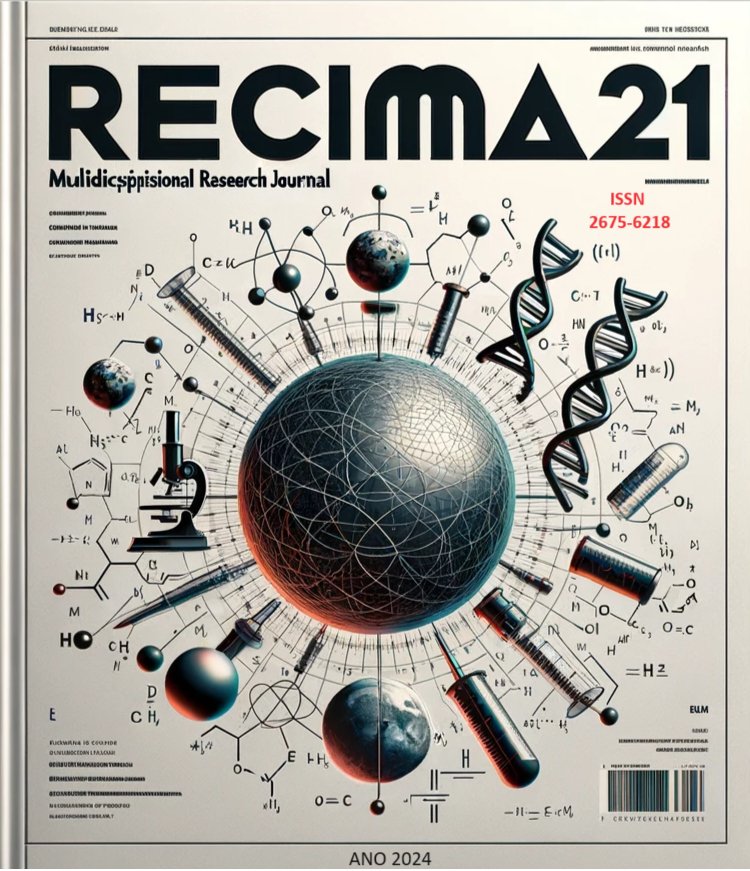MELASMA: INTRADERMOTHERAPY ASSOCIATED WITH TRANEXAMIC ACID AND NUTRACEUTICALS
DOI:
https://doi.org/10.47820/recima21.v5i4.5119Keywords:
Melasma; Tranexamic Acid; Hyperchromias; IntradermotherapyAbstract
Melasma is a pathology characterized by hyperpigmentation of the skin, resulting from an excess of melanin, a protein that guarantees our color and protection against ultraviolet radiation. This disorder results in the appearance of dark brown or grayish-brown spots that are delimited and have an irregular shape. With the aim of elucidating the aesthetic therapeutic interventions recommended for the treatment of melasma, this article addresses some of the most used protocols with proven results, such as: oral, topical treatment and in-office intradermotherapy sessions. The methodology used was the review of literature as well as treatment protocols and scientific articles, being searched on Pubmed, Google Scholar and articles published in full. However, it was possible to conclude that although melasma has no cure, there are combined treatments that promote the lightening of the existing spot and that if there is continuous treatment involving the professional and patient, the chances of a recurrence are low.
Downloads
References
Bagherani N. The efficacy of tranexamic acid in the treatment of melasma. Dermatol. Ther., Khorramshahr. 2015;28(4):265. DOI: https://doi.org/10.1111/dth.12200
Banihashemi M, Zabolinejad N, Jaafari MRM, et al. Comparison of therapeutic effects of liposomal Tranexamic Acid and conventional Hydroquinone on melasma. Journal of Cosmetic Dermatology 2015;174-177. DOI: https://doi.org/10.1111/jocd.12152
Costa M. Pele e anexos. [Tese de Doutorado]; Belo Horizonte: Unifal, Minas Gerais; 2023.
Elias P. Como analisar a pele em tratamentos estéticos com precisão. Youtube, 01 jul. 2018. Disponível em: https://www.youtube.com/watch?v=8I-FrqbaD7E.
Ebrahimi B, Naeini FF. Topical tranexamic acid as a promising treatment for melasma. J. Res. Med. Sci., Bethesda. 2014;19(8):753-757.
Fitzpatrick TB. The validity and practicality of sun-reactive skin types I through VI. Archives of Dermatology. 1988;12(6):869–871. [Acesso em: 11 maio 2021]; Disponível em: https://pubmed.ncbi.nlm.nih.gov/3377516/. DOI: https://doi.org/10.1001/archderm.124.6.869
George A. Tranexamic acid: an emerging depigmenting agent. Pig. Intern., Bangalore. 2016;3(2):66-71. DOI: https://doi.org/10.4103/2349-5847.196295
Goh CL, Chuah SY. O tratamento do melasma: uma revisão dos ensaios clínicos. Jornal da Academia Americana de Dermatologia. 2002;385-389
Gomes A, Bairral L, Lacerda S, Neto O, Izolani A. Ácido Tranexâmico: Diferentes formas de Utilização para Tratamento de Melasma. Brazilian Journal of Surgery and Clinical Research; 2020;29:88-92. Disponível em: https://www.mastereditora.com.br/periodico/20200105_095406.pdf
Mascena TCF. Melasma e suas principais formas de tratamento. 2016. [Monografia de Especialização em Biomedicina Estética]; Patos - PB: Instituto de Ensino Superior e Pesquisa, 2016. 45p.
Miot L, Silva M, Miot H, Marques M. Fisiopatologia do Melasma. An Bras Dermatol 2009. Disponível em: https://www.scielo.br/j/abd/a/gnfdb3Lp8fzRWqptsjfYtqr/?format=pdf&lang=pt. DOI: https://doi.org/10.1590/S0365-05962009000600008
Melo M, Magalhães A, Silva N, Liu P, Filho L, Gresta M, Santos A. Ensino mediado por técnicas de simulação e treinamento de habilidades de comunicação na área da saúde. Revista Médica de Minas Gerais. 2016;26. DOI: https://doi.org/10.5935/2238-3182.20160105
Tse TW, Hui E. Tranexamic acid: an important adjuvant in the treatment of Melasma. Perspectiva Andragógica de la Simulación Clínica. Revista Ciencia UNEMI. 2014;(2):37-46
Pinto CAS et al. Uso do pycnogenol no tratamento do Melasma. Curitiba. jun-ago., 2005;7(3):2018-222
Porto L, Ferreira T. Uso de ácidos na intradermoterapia no tratamento do melasma. Revista Scientia 21. 2023;2(1). Disponível em: http://revistas.icesp.br/index.php/Real/article/view/4489/2348.
Puga-Tejada M, Torres C. Perspectiva Andragógica de la Simulación Clínica. Ciencia Unemi. 2015;37-46. DOI: https://doi.org/10.29076/issn.2528-7737vol7iss12.2014pp37-46p
Rivitti EA, Sampaio SAP. Dermatologia. 3. ed. São Paulo: Artes Médicas; 2007.
Quilici AP. O que é simulação clínica e porque aplica-la na formação de profissionais de saúde? Escola de Ciências da Saúde da Universidade Anhembi Morumbi. Laureate Health Sciences Specialists; 2017.
Steiner D, Feola C, Bialeski N, Silva FAM. Tratamento do melasma: revisão sistemática. Surgical & Cosmetic Dermatology. 2009;1(2):87-94.
Tamler C, Fonseca R, Pereira F, Barcaui C. Classificação do melasma pela dermatoscopia: estudo comparativo com lâmpada de Wood. Surgical & Cosmetic Dermatology; 2009. Disponível em: https://docs.bvsalud.org/biblioref/2018/05/884356/2009_114.pdf.
Downloads
Published
How to Cite
License
Copyright (c) 2024 RECIMA21 - Revista Científica Multidisciplinar - ISSN 2675-6218

This work is licensed under a Creative Commons Attribution 4.0 International License.
Os direitos autorais dos artigos/resenhas/TCCs publicados pertecem à revista RECIMA21, e seguem o padrão Creative Commons (CC BY 4.0), permitindo a cópia ou reprodução, desde que cite a fonte e respeite os direitos dos autores e contenham menção aos mesmos nos créditos. Toda e qualquer obra publicada na revista, seu conteúdo é de responsabilidade dos autores, cabendo a RECIMA21 apenas ser o veículo de divulgação, seguindo os padrões nacionais e internacionais de publicação.













